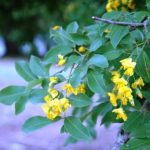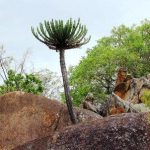TREE LIFE
SEPTEMBER 1991
MASHONALAND CALENDAR
Tuesday 3rd September: Botanic Garden walk with Tom Muller at 1645 hours for 1700 hours. Park your car at the Herbarium. Undoubtedly the garden will be showing that spring has arrived, always an exciting season botanically.
Sunday 15th September: It is some time since Harare members met up with Midlands folk, but this month we hope to renew acquaintances in Chegutu. Anne Bianchi has organised the outing which will start at 10:00 a.m. on Brian and Jennifer Watkins Farm – ‘Stanley’. Although the society has been there before, memories recall exciting species in the area such as Haplocoelum foliolosum, Hippocratea parvifolia and Manilkara mochisia.
Saturday 28th September: Walk with Mark on Borrowdale Common. Meet at 1500 hours at the corner of Teviotdale and Lanner Roads. Mark’s’ home phone number is 701023.
Tuesday 1st October: Botanic Garden walk
MATABELELAND CALENDAR
Sunday 1st September: To the Matopos, Bambata Cave Area, where we had so much success before. We have to exceed 81 species. Meet at Retreat at 0830 hours. Probably all day. Bring Tea, Lunch, Chairs.
Wednesday 18th September: McHEW— Back to the middle Wednesday of the month. Hillside Dams, Aloe Garden at 1700 hours.
Sunday 6th October: a morning outing in Val Deas’ stamping ground. Meet at her house, 35 Crouch Road, Matsheumhlope at 0830 hours.
Sunday November 3rd: We go to Mr Wood’s Glencurragh Farm, NYAMANDHLOVU. Details later.
A VISIT TO OUTWARD BOUND CHIMANIMANI
Saturday morning: Having settled in to our comfortable accommodation the night before, we were well fed, and then well briefed by Fen and Jacqui Goodes as to the areas which it would be best to explore. We began by identifying, and marking trees in the school grounds with a tag bearing the National number.
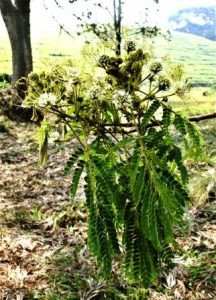
Albizia adianthifolia. Photo: Mark Hydi. Source: Flora of Zimbabwe
We were immediately plunged into a new world of unfamiliar species, and the Coates Palgrave was needed frequently. The first tree we came to turned out to be Albizia adianthifolia, finally distinguished from A. gummifera by its rough bark and furry leaflets.
Brachystegia microphylla was growing right next to B. utilis . “The Book” was again needed to identify the latter, which is similar in appearance to B. microphylla but has fewer and larger leaves. However as the brachystegias often hybridise we always feel in some doubt. B. spiciformis was also nearby.
Syzygium cordatum and S. guineense subsp. quineense were both represented, unfortunately bearing no ripe waterberries.
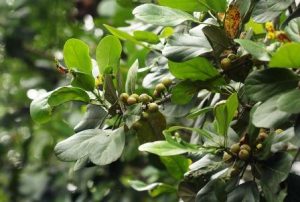
Uapaca sansibarica. Photo: Bart Wursten. Source: Flora of Zimbabwe
Much discussion ensued in a shady grove of Uapacas and parinaris. The occasional avocado tree caused some confusion in our efforts to identify Uapaca sansibarica which has smaller leaves and a longer petiole than U. kirkiana which was abundant indicating that frost on this hillside was rare or non existent.
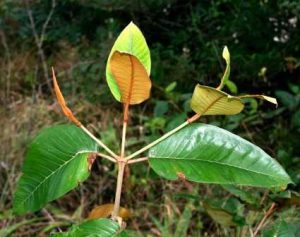
Harungana madagascariensis. Photo: Bart Wursten. Source: Flora of Zimbabwe
The family CLUSIACEAE was well represented by two easily identified species. Harungana madagascariensis is known to us as “praying hands” as the top two leaves are closely pressed together, resembling hands in prayer. The under surface of the leaves is densely covered with golden-orange hairs, and a broken petiole oozes bright, thick orange sap. Nearby was another family member Garcinia buchananii (formerly huillensis) which is hairless but oozes profuse bright yellow sap. The CLUSIACEAE includes the Hypericum and Psorospermum febrifugum which occur close by.
In all about twenty species were marked in the grounds.
-Cheryl Haxen
On Saturday afternoon we walked up the Haroni to Tessa’s Pool, labelling trees. This was my first experience of the current Tree Society labelling procedure. It is efficient. From identifying species, obtaining the national number, writing the label, through to fixing label to tree.
Tessa’s Pool deserves the prominence it achieves on the map. The river, falling suddenly over a dramatic little waterfall has in ages past gauged out a basin, in which, when we visited, the children and the brave, swam. Not fitting into either category, I did not swim.
The emphasis here I think is on the words “ages past”. One only has to look at the Chimanimani Mountains to sense the grandeur and mystery of it all. To look back, as through a window, to when our planet was young. My mind cannot comprehend much past the bare geological statement: “the quartzites and schists were thrust up and folded against the Melsetter Plateau in late Pre Cumbrian times”.
Beyond this I can only accept the workings of the Supreme Deity, to whom one may feel close, in the high and wild places.
On Sunday we hiked up a bit of the upper Hadange. Walking out of the school grounds, up over the first ridge before dropping down to the first crossing of the Hadange River.
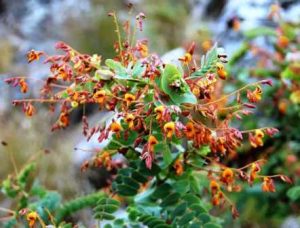
Aeschynomene grandistipulata. Photo: Bart Wursten. Source: Flora of Zimbabwe
Immediately we were waltzing among the Chimanimani endemics. Aeschynomene grandistipulata about 1.5 metre in height here but the book says it can reach twice this size. The leaves and stem are grayish glaucous green with huge stipules, 4 cm by 3 cm. Its three articled pods do not look at all like the “bikini top” simile we usually use to describe pods of this genus. At least not bikini tops worn by inhabitants of planet Earth, in other galaxies they maybe go in threes.
Nearby was another endemic of the same genus A. chimmanimaniensis with smaller leaves and stipules and according to the bikini analogy, more conventional two article pods. I have been told that a more orderly mind would liken these rather unusual constricted legume pods to bi-focal spectacles rather than the skimpy top of a swimming costume. Thank goodness I am not blessed with an orderly mind.
Lower down and in the riverine vegetation was yet another endemic, Vernonia muelleri, quite attractive in flower.
Once across the Hadange we commenced an ascent through an almost pure stand of Uapaca kirkiana. Why this species attains prominence here is not easy to understand.
It has the look of stability, close to climax woodland. Absence of frost clearly helps Uapaca but I suspect the hand of man is involved, selective tree cutting on these lower slopes has allowed Uapaca to gain a temporary dominance it is clearly unwilling to relinquish.
Rising higher, diversity of species increases, Brachystegia become more important, and soon the path merges into riveting woodland with all the variety of the eastern mountains flora. Still the real climax forest trees are not in evidence, all pointing to prolonged and selective extraction of desirable timber species. By diligent search, Mark did locate a baby Podocarpus, so we may hope for proper regeneration in time.
We had lunch at delightful river crossing in the midst of a natural fern garden.
From a broad aspect the Hadange is not much of a river, running as it does from its source a mere five kilometres until it meets the Haroni. But that short distance is packed with action. Through its middle course runs this ancient trackway, up over the mountain and into Mozambique, that this narrow pathway is still an important highway for international trade we could see because not long before we went that way one had spilt the beans, and some maize meal too.
Our little expedition did not allow much time off the path, but the few short forays I made lateral to our general line of walk provided a clue to a system of past possible frontier posts and way stations a century and more ago, under some earlier dynasty. It was maybe this human activity which was responsible for the selective tree felling noted above.
-George Hall
FOOTNOTE: Further to our picnic time discussion at the Hadange crossing Johnny Appleseed was an historic person. His real name was John Chapman, l774 to 1845, described as an American pioneer and folk hero. It is known he planted apple orchards but the many legends about him are unproven. He was no more a conservationist than the people who introduced the Port Jackson willow to the Cape and the rabbit to Australia.
12 August 1991: As usual the Tree Society organized a wonderful birthday, although the 7.00 am. chorus by Outward Bounders (energised by their icy pre breakfast swim in Tessa’s Pool) may be considered over the top. We soon trailed behind these youngsters into the Chimanimani up the Haroni River, past a series of pools each with its own character. The rocky banks are lined with trees, including Maytenus acuminata that kept us entertained as we cracked the leaves and stretched out the silky threads. One specimen was covered with red and green berries. As we approached excited voices up ahead we found that the gorge narrowed to a steep-sided crack. A dozen or so youngsters were spread-eagled across the rock face, clinging onto a water—supply pipe. Some of us retreated gracefully, the rest of us copied Spiderman only to learn that we then had to negotiate amazingly slippery rocks.
Fortunately these were well decorated with bunches of’ stag’s tongue ferns (Elaphoglossum). At least three of us slipped to ankle depth, enough to freeze the feet and squelch the toes. Eventually the gorge opened out to a deep pool with cascading waterfall. Once again the intrepid youngsters were sprawled along the cliff, searching for handholds and gripping onto the tough Xerophytes that somehow supports many climbers. A few of our party decided go take any alternative route offered. The rest followed the kids who had by now done a most remarkable Pied Piper trick and disappeared into a hole in the rock. My hips stuck in this keyhole long enough to realize that dieting was necessary, this resolution faded when Phil jammed in the same way. Now we were in the waterfall with nowhere to go. Then instructions from above told us to stand alongside the waterfall and ease up through the crack that the water was coming down, obvious really!!
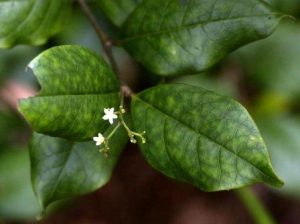
Cassinopsis tinifolia. Photo: Bart Wursten. Source: Flora of Zimbabwe
These exciting manoeuvres meant that trees took a second place for the day, but we did find an unknown species, (Cassinopsis tinifolia) passed tall Cyathea dregei and large specimens of Harungana. We eventually clambered out of the gorge past the widely creeping fern Dicranopteris linearis which shows the primitive features of indeterminate growth (the fronds grow a bit like stems) and dichotomous branching (fronds that divide into two). The shallow sides of the gorge support a Uapaca woodland, with both U. kirkiana and U. sansibarica. On the crest of the hill Brachystegia utilis were flushing in colours as bright as the more common musasa.
We returned to base before noon to enable some to head home. The return journey was enriched by the many Dalbergiella in full flower and Entada abyssinica in full pod, not to mention the delights acquired from the blessed cheesemakers of Chimanimani. We must thank Fen and Jacqui for a superb visit. Just like so many tourists I have only ever rushed up the Chimanimanis, I never realized there was so much interest in the foot hills.
-Kim Damstra
Our thanks to Fen and Jacqui Goodes for a wonderful experience and to the bounders for the ghost stories after lights out. M.S.J.
MATABELELAND NOTES: On Sunday, August 4th we went to Dr. M.L. Gelman’s farm, “Siyathaba”, in the Heany area, where he chiefly runs cattle. The part we visited consists of an immense long and deep ridge of wooded grassland, running roughly parallel to the Ncema River, and also down to it. At this season, it has permanent small rocky pools. In all, we identified some 73 species.
It was noted that there seemed to be about 7 differing “Micro-Habitats”, and that the species concerned tended to keep to their own, with some overlapping. I, personally, found this particularly interesting.
- The upper parts of the open wooded-grassland: were dotted with individually isolated specimens of: Albizia amara, Burkea africana, Carissa edulis, Cassine matabelica, Dichrostachys cinerea, Maytenus senegalensis, Parinari curatellifolia, Protea gaguedi, Pseudolachnostylis, Terminalia sericea.
- Lower down the ridge-still open wooded grassland, the above persisted, PLUS :
Faurea saligna, Ozoroa insignia, Pavetta schumanniana, Piliostigma thonningii – all similarly isolated.
A large number of the other species occurred in what might well be termed clumps (being small rocky outcrops and or termitaria, (anthills to most of us).
-
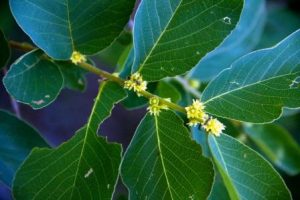
Bridelia mollis. Photo: Bart Wursten. Source: Flora of Zimbabwe
These clumps on the upper part of the ridge contained: Albizia antunesiana, Bridelia mollis, Carissa edulis, Cassine tranevaalensis, Combretum molle, Euclea natalensis, widespread, E. racemosa, E. undulata, (dwarfs) Flacourtia indica, Grewia flavescens, G. monticola, Pappea capensis, Peltophorum africanum, Pterocarpus rotundifolius, Turraea nilotica, Vitex payos and Ximenia caffra.
- Lower down on the ridge similar clumps contained many of these plus: Commiphora schimperi, Diospyros lycioides, Dovylalis zeyheri, Lannea discolor, Olea europaea, subsp. africana, Pavetta gardeniifolia, Psydrax livida, Rhus lancea, R. leptodictya, R. pyroides, Strychnos spinosa, Tarchonanthus camphoratus.
There were several good sized granite kopjes – standing out as islands in a sea of grass, excellent viewpoints, as most clearly the Bushman had found. They also left a good few paintings on these kopjes, together with several “industry” sites, full of microchips of rocks they had introduced there, such as Quartz, agates and ironstone.
- On the kopje fringe and nowhere else except down near the river, were all four Acacia species A. gerrardii, A. karroo, A. nilotica, A. rehmanniana.
- On the kopjes themselves were : Croton gratissimus, Erythrina latissima, Ficus glumosa, F. ingens, F. thonningii, Flacourtia indica, Mundulea sericea, Pouzolzia mixta, Pterocarpus angolensis, Schrebera alata.
- Down near the river was riverine vegetation and some clumps, including: Buddleia saligna, Combretum apiculatum, C. hereroense, and Ficus ingens and Salix mucronata.
Another interesting feature was a triple dyke of dolorite, crossing the river, and going up the opposite ridge.
All together a most interesting days outing, thanks to Dr. Gelman, who guided us.
-C.SYKES
NYARUDINDA CATCHMENT AUGUST 1991
What floral perfume stops you in your tracks .. . scent before sight; Spring has come and with it a sudden awareness of msasa flowers.
The Orbweb Spider
Vegetation connected by golden silk made by the female Orbweb Spider is comprised of the following species: Brachystegia boehmii, B. spiciformis, Combretum molle, Dichrostachys cinerea, Hyperthelia grass, Rhynchosia resinosa, Turraea nilotica, Grewia monticola and Vernonia adoensis (shaggy vernonia). All that remains of the web now, is a line bearing dried up caterpillars, the egg cases which had looked like four units of bubble pack in the vertical plane, resemble crumpled tissue paper. This description may help in locating the habitat of this spider whilst the Brachystegia woodland is ‘open.’
In Tree Life 136 June 1991, the liane Lepistemon shirensis deserved mention because of its bold form and interesting flowers. At Kyle we saw a Lepistemon sp. in fruit, the vines twined up into the canopy of trees and spilled over to our level as we stood on the Umvumila Dyke. It was gratifying to see how plentiful it was, so far only one plant has been located in this catchment, it struggles to display itself on a wire fence. Soils derived from dolorite are favoured by this grey leaved plant which belongs to the family CONVULVULACEAE.
Lepistemon shirensis is illustrated in Kirkia which is the Journal of the National Herbarium of Zimbabwe. These are in the reference library at the Herbarium, they are a bit intimidating but worth browsing through because of the papers on the Great Dyke flora, which are the result of investigations by Professor Hiram Wild.
The Great Dyke Aloe has a limited occurrence on the serpentine soils of the Northern section of the Dyke, i.e. from the Mvurwi Mountains to the Mvuradona Mountains, Aloe orthoclopha is said to be habitat specific.
The subject of rare plants has been studied with reference to the “Dyke”. More than 60 species of common and rare plants are found on the Northern section which are absent on the Southern Dyke. At least 20 species on the Southern section i.e. south of Darwendale, are confined to it and they do not occur on the Northern Dyke. There is no doubt that pig rooting by the miners threatens the naturally sparse populations of some of these plants.
It is noteworthy that the two sections of the “Dyke” are botanically separated by a geological island of norite rock.
The “Dyke“ flora offers examples of naturally rare species and man-made rarity. The ultimate is extinction in the wild. The word ‘speciation’ crops up in Tree walks, is it synonymous with hybridization ? . . . this is perhaps nature’s way of avoiding extinction of a species, it may live on in a new guise, this makes botany even more difficult.
Tree Atlassing
This project will reveal the common-ness or rarity of our trees and shrubs, and hopefully, lianes too. It will indicate how threatened certain species have become in a particular locality, more happily it will show the increased distribution of some species e.g. Brachystegia allenii. Let us hope that there will be more additions than deletions on the distribution maps.
Christmas Seal Campaign.
The R.AP.T. Christmas Seals will send Aloe ortholopha all round the world.
Kashawa kopje, completion of Catena transect
The frequented granite kopje was searched whilst my companion waited close by, he spoke about a big snake with blue on its neck which he had seen moving between a termite mound and these rocks. The usual, tree species composition for this situation did not divert attention from the possibility of meeting something. The size of a dassie midden showed there was plenty of food for predators. Pterocarpus angolensis grew amongst smooth-barked fire sensitive trees, vernacular names for this species refer to blood e.g. mubvamaropa and to rock-rabbit e.g. mukambira and mukwirambira, (not to be confused with the word for an African piano). Here is a proverb, by sending someone to fetch his tail, the rock-rabbit did not get one.
Four fig trees grew at the foot of the kopje, Ficus glumosa, flowering- over; F. sur, F. sycomorus and F. stuhlmannii stood alone on level ground where seepage and humus had enriched the soil. This situation suited Protea angolensis, Peltophorum africanum and Elephantorrhiza goetzie.
Herbarium Numbers: Mr Bob Drummond introduced the list of National Tree Numbers in 1975, these are coming into more general use, are these their Herbarium Numbers?
Please could the answer to this question appear in the next Tree Life.
The beautiful flowers of Clerodendrum myricoides are just about to open, it is a pity that they are borne on leafless stems.
Mbagazeurs Ancient Dark and National Monument, Mashonaland west. A stunted evergreen tree grows just below the summit of this massive sloping rock, samples of this tree usually get lost during the descent, recently one arrived at the “Herbs”, its identity puzzled us. Derek Henderson and others will recognise the name, it was a plant out of place, Euclea natalensis. Amongst parched grass and stones the ‘shrublet’ Crotalaria cepholates was conspicuous for its compact inflorescence each surrounded by a dense ruff of grey-green trifoliate leaves.
-Benedicta Graves
Anton Ellert and Mary Wilkins have an impressive list of indigenous trees for sale.
They include 8 Acacia species, 3 Albizia species, Erythrina sp., Sclerocarya birrea, Cordia grandicalyx and the beautiful C. abyssinica, Colophospermum mopane, Adansonia digitata, Afzelia quanzensis and Cordyla africana which attracts hundreds of birds when in flower. Also for the birds, many aloes. The unusuals include Cussonia natalensis, Garcinia livingstonei, Guibourtia coleosperma and G. conjugata, Holarrhena pubescens, Sapium ellipticum and Podocarpus latifolius, the list is long with over 100 species.
In addition, they offer contract growing of indigenous trees, shrubs and succulent plants.
For further information contact Anton or Mary on Telephone No. (171) 64131.6 Bindura, or write to P 0 Box 181, Bindura.
Botanic Garden Walk. The Fig Family, MORACEAE
For the past two months we have looked at the fig family, MORACEAE. We have looked at the classification, reproduction and evolution of the fig family. This month we continued to look at Figs and Tom mentioned figs with fungicides, so I thought I appropriate to build on this idea and look at fig protection before we go on to look at the plants studied during this Botanical Garden walk.
One of the features of the family MORACEAE is the milky sap. This sap is a feeding deterrent stopping herbivores from eating the plant. When the fruit is young and unripe and it is picked, the milky sap comes out but when the fruit is ripe it does not have the sap. This stops animals from picking unripe fruit when the mating of the wasps inside has not taken place and when the seeds have not fully developed.
Another Feeding deterrent found in figs and a lot of the unspecialised families is tannin. When the leaves are undisturbed, tannin is stored in special structures within the leaves. When the leaves are chewed, these special structures are destroyed releasing the tannin which locks onto the protein of the leaves reducing the nutritive value of the plant. This means that even after eating a lot of Fig leaves, an animal will still be hungry and the animal soon learns to associate this hunger with fig leaves and learns to avoid fig leaves. Tannin also binds to enzymes and other proteins reducing the efficiency of digestion. Some scientists in South Africa reported that the intestines of browsers feeding on figs and Burkea africana (also containing tannin) were beginning to look like leather because of the interaction between tannin and protein structures.
Tannin is an astringent which causes the puckering of the tongue – this astringency is a repellent to many animals, insects and birds. It is on this astringency that women (and men) all over the world base their tea making recipes, as well as use tea to sooth and refresh tired eyes.
Fig leaves also have cystoliths which are translucent small calcium stones. These are also a feeding deterrent. Some leaves are rough e.g. in Ficus capreifolia and this also stops animals from feeding on the leaves.
Besides protecting themselves against being browsed, figs also protect themselves from disease. Most plant diseases are bacterial or fungal (yeasts, mushrooms and their relatives) in origin and figs have evolved fungicides to kill both bacteria and fungi (the equivalent to our antibiotics) penetrating their tissues. Ficus scassellatii produces a fluid in its syconia which is a fungicide. The milky sap also kills some bacteria and as in most trees the bark provides some protection.
The ability of plants to protect themselves is one of the features that has enabled plants to be successful. The plants looked at this month were – Ficus fischeri occurring in Zambia, it is not three veined from the base. The tree in the Botanical Gardens is nine years old. F. craterostoma which is very close to F. natalensis is also not three veined from the base but it keeps its stipules for much longer than other figs. F. stuhlmannii which is typical of the northern middle veld has very small leaves and a black stem with white spots which is very unusual for figs as they usually have light stems. This Fig occurs in Rafingora and Chegutu. F. abutilifolia has one of the largest round leaves, the specimen in the Botanical gardens was associated with lichens. F. capreifolia lays down a lot of branches laterally before growing up. Depending on whether or not you pick the ‘right’ branch this fig can be mis-classified as RUBIACEAE which has opposite leaves with interpetiolar stipules and not alternate leaves. It does not occur in the high veld, F. scassellatii has leathery leaves (feeding deterrent) which are not three veined from the base. It is a strangler fig occurring in the Bunga Forest.
Ficus thonningii is a high rain forest fig whose roots grow down from the branches. F. lutea is found from Chipinge to Chirinda. The fruit occurs at the end of the branches and the leaves are 5 veined from the base. F. exasperata (Tom’s toilet paper tree) occurs in the Vumba and Burma Valley. Its leaves are very rough (sandpaperish) and tough. The sap is not milky but clear, it’s three veined from the base and the fruit is borne at the ends of the branches. F. bubu has roots close to the surface, the tree in the Botanical Gardens has never had viable seeds. The reason could be that the right wasp is not found in the gardens or that it is one of two gyanodiocious figs. F. vallis-chudae is a very rare fig with only 12 – 15 plants in Zimbabwe. This fig looks very unhealthy in winter but bears very big soft fruit.
Thank you Tom for another enjoyable walk.
-FRAN MUTAPI.
Not many of us are aware of the existence of a delightful tea garden set in unspoiled woodland on the northern shore of Lake Chivero. Tea and cream scones can be enjoyed in peace whilst watching wild birds. Lake Tea Garden is about 500 metres beyond the Hunyanl Hills Hotel.
KIM DAMSTRA CHAIRMAN


